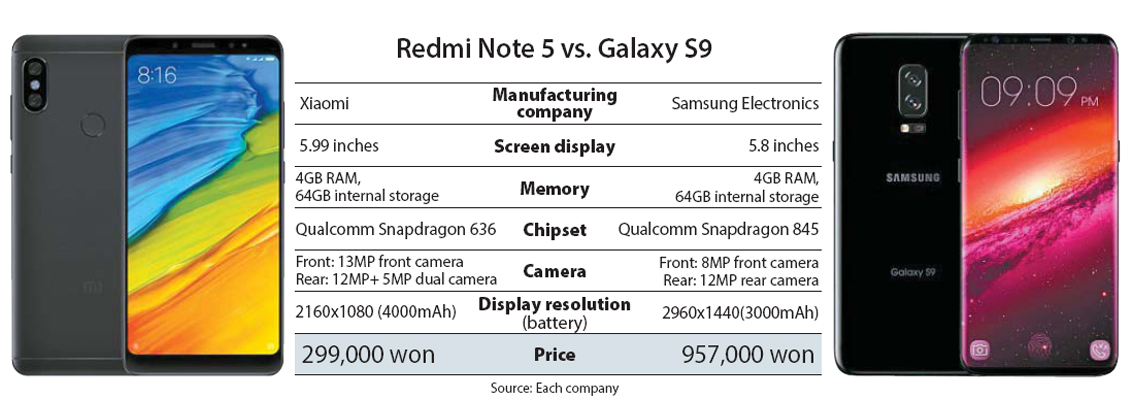Xiaomi’s arrival rocks local smartphone market

The newest smartphones from Xiaomi and Samsung - the Redmi Note 5 and Samsung Galaxy S9 - are equipped with very similar features. Both have 4 gigabytes (GB) of RAM with 64 GB of internal storage, while the Redmi Note 5 has a 4,000 mAh battery and the Galaxy S9 has 3,000 mAh.
The Redmi Note 5 has a 13-megapixel front camera and 12-megapixel and 5-megapixel dual rear cameras, while the Galaxy S9 has an 8-megapixel front camera and a 12-megapixel rear camera.
The main difference between these handsets lies in their price - the Redmi Note 5 is now selling for 299,000 won ($265), a third of the Galaxy S9’s 957,000 won price tag.
“The Redmi Note 5 is selling better than other foreign smartphone brands like Huawei and ZTE,” said a spokesman from a mobile carrier, without revealing specific numbers.
One of the main reasons Chinese handset makers have been able to keep churning out low-cost yet high-functioning phones is lowered production costs from government subsidies.
Beijing is currently pushing for the “Made in China 2025” initiative to nurture homegrown manufacturing of high-tech products in pharmaceuticals and information technology. Towards that end, the Chinese government has been providing perks to smartphone makers like tax cuts.
Korean manufacturers are finding it difficult to compete on a level platform in the budget smartphone market.
“We should make a profit from selling,” said an industry spokesman, “but pricing our goods at the level of Chinese companies means we have to sell at a loss.”
Global smartphone sales data shows that Beijing’s efforts have not gone to waste.
Xiaomi’s global market share for this year’s first quarter reached 7.4 percent, up from 3.4 percent in last year’s first quarter, according to global research company Gartner. During the same period, Chinese maker Huawei’s market share also grew from 9 percent to 10.5 percent on-year, while Samsung’s fell from 20.7 percent to 20.5 percent.
“Koreans have high standards when it comes to expectations for smartphones,” said an industry spokesman who requested anonymity. “Many have doubts when it comes to Chinese products’ quality, features and after-sales service.”
While domestic sales of Korean phones still far outnumber sales of foreign phones, consumers are beginning to warm up to Chinese handsets as positive reviews spread and Chinese companies actively localize their marketing strategies.
“[Xiaomi] dedicated a lot of time to trying to understand the Korean market and adjust to it,” said CEO Jenny Jung of Gemovi, Xiaomi’s official Korean partner. “It is expanding its sales routes as well as its after-sales service options.”
BY CHOI HYUN-JU [kim.eunjin1@joongang.co.kr]










with the Korea JoongAng Daily
To write comments, please log in to one of the accounts.
Standards Board Policy (0/250자)